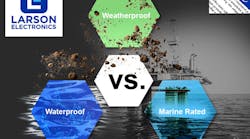Waterproof vs. Weatherproof vs. Marine Rated
Weatherproof, waterproof and marine-rated are frequently used terms to describe industrial equipment, lighting systems, tools and etc. These terms vary greatly and must be fully understood, in order to ensure proper application of the product.
Defining Weatherproof
Weatherproof is a loosely used term to describe the resilience of an object or material against a wide range environments and conditions. Such elements typically include rain, light snow, wind and light contact. Without a standard to adhere to, manufacturers must define exactly how weatherproof a product really is. This is because customers may have different interpretations of weatherproof, when it comes to application.
In the event a clear definition of weatherproof is unavailable on the product label or manual, individuals should look at the unit’s ratings or features. For example, a weatherproof transformer with a NEMA 3R rating suggests the device can withstand icy conditions, falling dirt and the ingress of water. Such information is more reliable because NEMA is a regulated standard; compared to weatherproof (which is not, as the term is only a description).
Generally speaking, weatherproof products utilize materials that can stand up against bad weather. Such devices are designed for outdoor use, under unpredictable weather conditions.
With that in mind, a manufacturer may opt to apply coatings or finishes on the surface to deter damage, apply sealed or tight designs and use materials that do not rust easily. Corrosion can be tolerated by weatherproof products, but only up to a certain point. Saltwater corrosion is rarely covered in the scope of ‘weatherproof’ (unless stated by the manufacturer), though minimal corrosion from rainwater may be tolerated.
Waterproof Standards and Ratings
Waterproof is defined as resistance to the ingress of water or moisture. In reference to waterproof enclosures, one would expect the housing to keep the contents inside dry and functioning normally, even when exposed to torrential rain or splashes of water. The type of waterproofing method depends on the type of product. Waterproof fabrics are usually treated with special coatings, while waterproof lights may feature water-tight or IP-rated enclosures.
Unlike weatherproof, waterproof can be clearly defined without clarification from the manufacturer, using the IP rating scale. An IP rating provides the level of waterproofing a product is capable of, which is based on a standardized scale (EN 60529 [British BS EN 60529:1992, European IEC 60509:1989]). In an IP rating, the second digit dictates the level of waterproof protection. The first digit highlights protection from intrusion (solid objects, dirt, rough contact).
For instance, an LED flood light with an IP68 waterproof rating suggests the unit is dust tight (referencing the number six in the rating) and offers protection from water immersion for long periods of time (referencing the number eight in the rating).
Compared to weatherproof, waterproof levels accompanied with an IP rating is considered to be a more transparent method for determining a product’s ability to withstand harmful, outdoor environments and conditions.
Marine Rated 101
Marine rated or marine grade refers to a products ability to withstand elements associated with marine environments, such as water, strong winds, rough contact and saltwater corrosion. In most cases, the main focus of marine-rated equipment is protection from saltwater corrosion, as such elements is a leading cause of premature product failure at sea, docks or during shore-based operations.
In order to deter saltwater corrosion, manufacturers leverage superior materials. An example of this is the use of molybdenum in marine-grade stainless alloys, including 316 stainless steel. This type of material can be found on enclosures for portable power distribution systems designed exclusively for marine locations, industrial lighting products and more. Other types of marine-grade materials include the following: AH36, DH36 and EH36 (carbon steel); grade 5052 and 6061-T6 (aluminum); and C65500 (silicon bronze).
Marine-rated devices may also be treated with resilient coatings to ensure adequate protection from saltwater corrosion. Galvanization is a common method for achieving such features, which involves dipping the material or product in hot zinc. Anodizing is a type of chemical treatment process using an electrolytic acid bath (highly applicable to aluminum). It is designed to strengthen the material, allowing it to withstand saltwater corrosion.
Tip: To ensure proper protection from water and saltwater corrosion in marine environments, it is best practice to use marine-rated equipment. Based on their respective definitions, waterproof products (without marine ratings), although reliable, may not offer complete protection from saltwater corrosion.










